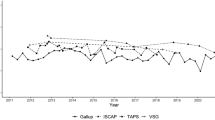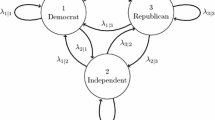Abstract
This essay refines and extends our argument (Green and Palmquist, 1990) that net of the distorting effects of measurement error, Americans' partisanship tends to be highly stable over time. Three challenges to this thesis are addressed. In response to doubts about the generalizability of our earlier findings to panel studies of longer duration or from other eras, we show that nine multi-wave panel studies yield similar results. Next, we take up the question of whether our model can account for observed patterns of partisan conversion. The rate of party-switching forces some modifications in the statistical assumptions used to model party identification over time, but a revised model which can account for inter-party change reproduces earlier findings of partisan stability. Third, we grapple with the question of how our findings square with fluctuations in what has been termed “macropartisanship”. We suggest that aggregate shifts in party identification need not be incompatible with strong over-time correlations at the individual level. Finally, we develop a simulation of micropartisanship to illustrate that over long stretches of time very gradual changes in partisanship can accumulate to produce appreciable levels of micropartisan change.
Similar content being viewed by others
References
Abramson, Paul R., and Charles W. Ostrom, Jr. (1991). Macropartisanship: An empirical reassessment.American Political Science Review 85: 181–192.
Abramson, Paul R., and Charles W. Ostrom, Jr. (1992). Question wording and macropartisianship: Response.American Political Science Review 86: 481–486.
Achen, Christopher H. (1975). Mass political attitudes and the survey response.American Political Science Review 69: 1218–1231.
Allsop, Dee, and Herbert F. Weisberg. (1988). Measuring change in party identification in an election campaign.American Journal of Political Science 32: 996–1017.
Asher, Herbert B. (1974). Some consequences of measurement error in survey data.American Journal of Political Science 18: 469–485.
Babakus, Emin, Carl E. Ferguson, Jr., and Karl G. Jöreskog (1987). The sensitivity of confirmatory maximum likelihood factor analysis to violations of measurement scale and distributional assumptions.Journal of Marketing Research 24: 222–228.
Brody, Richard A. (1991). Stability and change in party identification: Presidential to off-years. In Paul M. Sniderman, Richard A. Brody, and Philip E. Tetlock (eds.),Reasoning and Choice: Explorations in Political Psychology. New York: Cambridge University Press.
Brody, Richard A., and Lawrence S. Rothenberg (1988). The instability of partisanship: An analysis of the 1980 presidential election.British Journal of Political Science 18: 445–465.
Campbell, Angus, Philip E. Converse, Warren E. Miller, and Donald E. Stokes (1960).The American Voter. New York: Wiley.
Converse, Philip E. (1969). Survey research and the decoding of patterns in ecological data. In Mattei Dogan and Stein Rokkan (eds.),Quantitative Ecological Analysis in the Social Science, pp. 459–485, Cambridge, Massachusetts: M.I.T. Press.
Converse, Philip E. (1976).The Dynamics of Party Support: Cohort-Analyzing Party Identification, Beverly Hills: Sage Publications.
Converse, Philip E., and Gregory B. Markus (1979). Plus ça change...: The new CPS election study panel.American Political Science Review 73: 32–49.
Converse, Philip E., and Roy Pierce (1992). Partisanship and the party system.Political Behavior 14: 239–259.
Dreyer, Edward C. (1973). Change and stability in party identifications.Journal of Politics 35: 712–722.
Fiorina, Morris P. (1981).Retrospective Voting in American National Elections. New Haven: Yale University Press.
Franklin, Charles H. (1992). Measurement and the dynamics of party identification.Political Behavior 14: 297–309.
Franklin, Charles H., and John E. Jackson (1983). The dynamics of party identification.American Political Science Review 77:957–973.
Green, Donald Philip (1990). The effects of measurement error on two-stage leastsquares estimates.Political Analysis 2: 57–74.
Green, Donald Philip, and Bradley Palmquist (1990). Of artifacts and partisan instability.American Journal of Political Science 34: 872–902.
Green, Donald Philip, and Eric Schickler (1993). Multiple measure assessment of party identification.Public Opinion Quarterly 57: 503–535.
Jackson, John E. (1975). Issues, party choices, and presidential votes.American Journal of Political Science 19: 161–185.
Jöreskog, Karl G., and Dag Sörbom (1988). LISREL VII. Mooresville, Indiana: Scientific Software.
Kenny, David A., and Donald T. Campbell (1989). On the measurement of stability in over-time data.Journal of Personality 57: 445–481.
Keith, Bruce E., David B. Magleby, Candice J. Nelson, Elizabeth Orr, Mark C. Westleye, and Raymond E. Wolfinger (1992).The Myth of the Independent Voter. Berkeley: University of California Press.
Kramer, Gerald (1983). The ecological fallacy revisited: Aggregate versus individual-level findings on economics and elections and sociotropic voting.American Political Science Review 77: 92–111.
Krosnick, Jon A. (1991). The stability of political preferences: Comparisons of symbolic and nonsymbolic attitudes.American Journal of Political Science 35: 547–576.
Krosnick, Jon A., and Duane F. Alwin (1989). Aging and susceptibility to attitude change.Journal of Personality and Social Psychology 57: 416–425.
MacKuen, Michael B., Robert S. Erickson, and James A. Stimson (1989). Macropartisanship.American Political Science Review 83: 1125–1142.
MacKuen, Michael B., Robert S. Erickson, and James A. Stimson (1992). Question wording and macropartisanship.American Political Science Review 86: 475–481.
Markus, Gregory B. and Philip E. Converse (1979). A dynamic simultaneous equation model of electoral choice.American Political Science Review 73: 1055–70.
Miller, Warren E. (1991). Party identification, realignment, and party voting: Back to basics.American Political Science Review 85: 557–568.
Nie, Norman H., Sidney Verba, and John R. Petrocik (1979).The Changing American Voter (expanded edition). Cambridge, Mass.: Harvard University Press.
Page, Benjamin I., and Calvin C. Jones (1979). Reciprocal effects of policy preferences, party loyalties, and the vote.American Political Science Review 73: 1071–1089.
Palmquist, Bradley, and Donald P. Green (1992). Estimation of models with correlated measurement errors from panel data.Sociological Methodology 1992. Washington, D.C.: American Sociological Association.
Rigdon, Edward E., and Carl E. Ferguson, Jr. (1991). The performance of the polychoric correlation coefficient and selected fitting functions in confirmatory factor analysis with ordinal data.Journal of Marketing Research 28: 491–497.
Schickler, Eric, and Donald Philip Green (1995). Issue preferences and the dynamics of party identification: A methodological critique. In John R. Freeman (ed.),Political Analysis (Volume 5), Ann Arbor: University of Michigan Press.
Schuman, Howard, Charlotte Steeh, and Lawrence Bobo (1985).Racial Attitudes in America: Trends and Interpretations. Cambridge, MA: Harvard University Press.
Sears, David O., and Carolyn L. Funk (1990). The Persistence and Crystallization of Political Attitudes over the Life-Span: The Terman Gifted Children Panel. Revision of a paper originally presented at the Annual Meeting of the American Sociological Association, August 11, 1990.
Shanks, J. Merrill, and Warren E. Miller (1990). Policy direction and performance evaluation: Complementary explanations of the Reagan elections.British Journal of Political Science 20: 143–235.
Sharma, Subhash, Srinivas Durvasula, and William R. Dillon (1989). Some results on the behavior of alternate covariance structure estimation procedures in the presence of non-normal data.Journal of Marketing Research 26: 214–221.
Weisberg, Herbert F., and Charles E. Smith, Jr. (1991). The influence of the economy on party identification in the Reagan years.Journal of Politics 53: 1077–1092.
Whiteley, Paul F. (1988). The causal relationships between issues, candidate evaluations, party identification, and vote choice—the view from “Rolling Thunder.”Journal of Politics 50: 961–984.
Wiley, David E., and James A. Wiley (1970). The estimation of measurement error in panel data.American Sociological Review 35: 112–117.
Wiley, James A., and Mary Glenn Wiley (1974). A note on correlated errors in repeated measurements.Sociological Methods & Research 3: 172–188.
Additional information
Donald Philip Green, Yale University.
Bradley Palmquist, Harvard University.
Rights and permissions
About this article
Cite this article
Green, D.P., Palmquist, B. How stable is party identification?. Polit Behav 16, 437–466 (1994). https://doi.org/10.1007/BF01498826
Issue Date:
DOI: https://doi.org/10.1007/BF01498826




